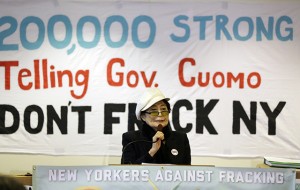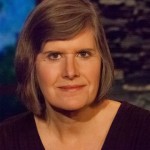Reverend Judson’s crime might have been prevented had Missouri-based Inergy Midstream not bought the old U.S. Salt Company plant on the west bank of Seneca Lake in 2008, along with 1.2 miles of shoreline beneath which lie abandoned salt caverns. Inergy’s intent was — and is — to repurpose these chambers for the storage of propane, butane, and methane (natural gas) from the fracking fields of Pennsylvania. Millions of barrels’ worth. Only the volatile gases won’t be in barrels. The containers will be the caverns themselves.

A drilling rig is set up near a barn in Springville, Pa., to tap gas from the giant Marcellus Shale gas field. Inergy Midstream plans to store the gases captured through fracking in Pennsylvania near Seneca Lake, in Upstate N.Y. (AP Photo/Alex Brandon, File)
To do this, Inergy plans to drill into the caverns, siphon out the brine they contain and replace it with liquefied gas. Such transfers require brine pits, flare stacks and enormous pressure. Thus, formaldehyde-emitting compressor stations — such as the one whose fence Reverend Judson, on a blue September morning, chained himself to. Formaldehyde is a known human carcinogen.
Of the seventeen people who gathered at the Inergy compressor station site, I (age fifty-three) was one of the youngest. The oldest was eighty-five. Many protesters had roots in the region going back generations. What they talked about was frustration.
Frustration because Inergy is duplicitous: It reassures the public that its plans are modest but boasts to investors of its aim to become the gas storage and transportation hub for the entire Northeast. Frustration because Inergy has a ghastly safety record, including repeated equipment failures. Because Inergy has started drilling even before its environmental impact statement is finalized and permits granted. Because the rail and truck depot that Inergy is building will fill our roads and train trestles with rolling tankers full of explosive materials. Because Inergy has, since July, already spilled more than fifteen thousand gallons of brine, killing lakeside trees. Because Seneca Lake is a drinking water source for 100,000 people. Because the state turns a blind eye.
While chained to the compressor station fence, Reverend Judson, an avid fisherman, spoke about the sparkling lake behind him. “They don’t have the right to do this — to put the lake in jeopardy. We’ll all end up paying for their mess.” I was impressed not only with the force of Judson’s moral argument but also with his knowledge of aquatic ecology, climate change and the arcane details of environmental regulation. This is a man who can talk water-quality indices as well as apostles.
“Inergy has been in violation of the Clean Water Act at this facility every single quarter for the past three years,” he said. “Since 1972, there have been fourteen catastrophic failures at gas storage facilities. Each one of them has been at a salt cavern.”
When the sheriff and his deputies arrived and most of the protesters dispersed, Judson did not. No sooner had bolt cutters emancipated him from the fence than handcuffs re-manacled him. As he was led away, his wife (age seventy-four) ran up and adjusted his glasses.
Even though, as of this writing, fracking is still illegal in New York State, the de facto moratorium has not prevented the rapid build-out of fracking’s infrastructure. Twenty miles from Reading lies the riverside town of Horseheads, which now hosts a $40 million way station for fracking chemicals and explosives. All this sits atop an aquifer that supplies drinking water for thousands of people. Meanwhile, a new high-pressure pipeline burrows under the Hudson River to carry natural gas from fracking wells into lower Manhattan, and construction of a 12,260-horsepower compressor station (which will emit 61,000 tons of air pollutants per year) is under way in the town of Minisink, New York, just a few miles northeast of the New Jersey border. These facilities have all been sites of protest and outbreaks of civil disobedience, as citizens do what they can to halt the full-scale industrialization of the region at the behest of the gas industry.

Yoko Ono — a member of Artists Against Fracking — speaks during a news conference opposing fracking on Jan. 11, 2013, in Albany, N.Y. (AP Photo/Mike Groll)
I’m working on pulling together Biologists Against Fracking but am having a tough time of it. Even the scientists whose own research shows harm from drilling and fracking operations are hesitant to speak out. Some fear loss of grant money. Some believe their objectivity will be questioned — as though objectivity and neutrality were the same thing. Some are just so, so busy. And some believe fracking is inevitable. The result is political silence, a stunning position for physicians under oath and other medical professionals studying such things as cancer-causing chemicals.
As I watch scientists with evidence position themselves above the fray while faith leaders quote from their data while chained to fences, I wonder if I might not be saved by religion after all. I do know that silence is consent. That we have a duty to protect our communities, especially our children, not just by studying how toxicants behave in the environment but by taking action to prevent their introduction and release. And that the words that echoed through the sanctuary of my childhood church have been returning to me in the sleepless hours.
Call to Worship. Psalm 25: Let them be ashamed who are clothed with treachery.
 (photo: Dale Robbins) |
Ecologist and author Sandra Steingraber has been a columnist for Orion magazine since 2007. Steingraber is currently a scholar in residence in Ithaca College and is recognized for her ability to serve as a two-way translator between scientists and activists. Her highly acclaimed book, Living Downstream: An Ecologist’s Personal Investigation of Cancer and the Environment was the first to bring together data on toxic releases with data from U.S. cancer registries and won praise from international media. |

